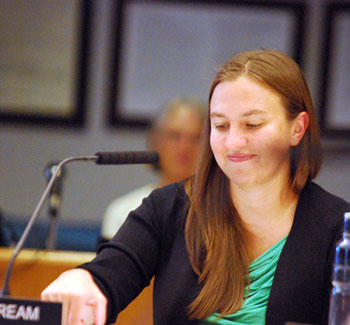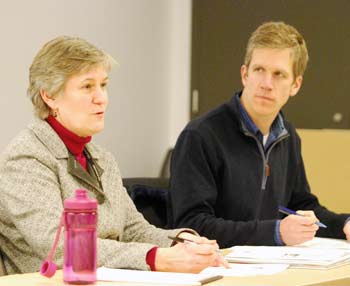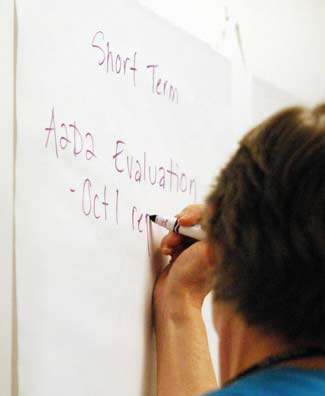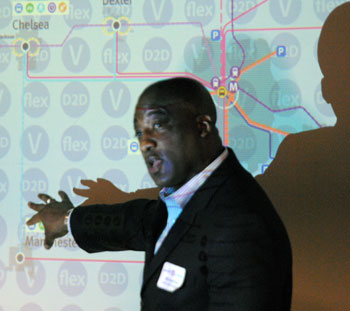Ann Arbor Area Transportation Authority board meeting (Aug. 15, 2013): The board’s two main voting items at Thursday’s regular monthly meeting were in some sense ceremonial – but still reflected substantial policy decisions.

Gillian Ream is the city of Ypsilanti’s representative on the newly expanded Ann Arbor Area Transportation Authority board. (Photos by the writer.)
The board gave public notice through a formal resolution that the organization would start using the new name specified in its newly-amended articles of incorporation: “Ann Arbor Area Transportation Authority.”
Eli Cooper, who also serves as the city of Ann Arbor’s transportation program manager, was among the board members at the meeting who noted the substance underlying the addition of the word “area” to the organization’s name.
That substance is a recently approved revision to the articles of incorporation of the AATA, which added the city of Ypsilanti as a member to the authority. The AATA board had given final approval for that change at its June 20, 2013 meeting, after the city councils of Ann Arbor and Ypsilanti had already approved the change. The revision to the articles to include Ypsilanti as a member is intended to provide a way to generate additional funding for transportation. The AAATA could, with voter approval, levy a uniform property tax on the entire geographic area of its membership – something the AATA did not do.
The cities of Ann Arbor and Ypsilanti now levy their own millages, which are transmitted to the AAATA. However, Ypsilanti is currently at its 20-mill state constitutional limit. A millage levied by the AAATA would not count against that 20-mill cap. While there had been an outside chance that a millage request could be placed on the ballot as soon as November 2013, it now appears likely for May 2014.
Board discussion reflected the fact that the new acronym for the organization is a challenge to pronounce letter-by-letter. Suggestions had been made to adopt a convention of calling the AAATA “A3TA” or “Triple-A-TA” – but the board’s resolution indicated only that “TheRide” will continue as the organization’s mark.
Gillian Ream is the city of Ypsilanti’s new appointee to the expanded board of the AAATA. The Aug. 15 meeting was the second one she’d attended – but her first as a voting member.
The draft FY 2014 budget, for the fiscal year that begins on Oct. 1, already reflects the membership of the city of Ypsilanti – as the proceeds from Ypsilanti’s transit millage are recognized under “local property tax revenue” instead of “purchase of service agreements.” That draft currently shows about $33.3 million in both revenues and expenditures.
The FY 2014 work plan – which that budget is supposed to support – was the second ceremonial but still substantive item on the board’s agenda. In addition to maintaining a range of basic transportation services, the work plan includes a number of other initiatives. Among them are projects that have been widely discussed for a longer time – like increased services in the “urban core,” the east-west commuter rail, north-south commuter rail (WALLY) and a high-capacity connector between northeast Ann Arbor through the University of Michigan campus and farther south to the Briarwood Mall area. Projects included in the work plan that have not received as much publicity include traffic signal prioritization (in favor of public transit vehicles) and a unified fare media (payment) strategy.
Sue Gott noted during the meeting that the work plan had been under development for five months. The plan was met with general enthusiasm by board members, with Susan Baskett reflecting the board’s sentiment: “I just love this document!” It was adopted on a unanimous vote.
The other voting item on the agenda was authorization to use three different printers for small-scale print jobs over the next five years. The only wrinkle to approval of that item came in connection to adjusting the sequence of resolutions, so that the resolution formally adopting the AAATA’s new name preceded the printing contracts.
Also during the meeting, the board heard a range of public commentary. Among the points made by the public was the fact that despite discussions about possible changes to Route #11 in Ypsilanti, Route #11 will remain unchanged this fall. Also during public commentary, the passing of longtime disability activist Lena Ricks was noted. Ricks had served on the AAATA’s local advisory council. [Full Story]









